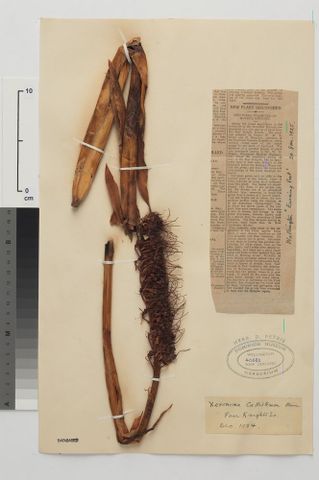Something spectacular is happening around Wellington – Poor Knights lilies (Raupo taranga; Xeronema callistemon) are bursting into flower!

In contrast to the tiny inconspicuous white flowers typical of many New Zealand endemic plants, Poor Knights lilies have bright red flower spikes that look a little like bottlebrushes. But despite these flamboyant displays Poor Knight’s lilies appear to be undervalued horticulturally compared to the popularity of another of New Zealand’s red flowered plants, the pohutukawa.

Poor Knights lilies only occur naturally on Northland’s Poor Knights Islands and Taranga Island in the Hen and Chickens Group, but are absent from islands between these two sites and the adjacent mainland. Surprisingly this species was only discovered by botanists less that 90 years ago during a Dominion Museum collecting trip. One of the original collections of this plant by its discovers, WRB Oliver and H Hamilton, is a specimen in Te Papa’s herbarium. The herbarium sheet also includes a clipping of a 1925 newspaper article from the Evening Post describing the new discovery.

In the wild this species grows on cliffs and rock outcrops where they can form huge clumps up to four metres across. They are very cold sensitive and can’t tolerate even mild frosts but seem to handle coastal conditions. They are reasonably easy to grow given the right conditions (see propagation techniques for this species) but patience is required as it can take many years before the plants are large enough to begin flowering. Perhaps this is why they aren’t more widely grown.
The Poor Knights lily has no close New Zealand relatives. The only other species in the genus Xeronema is the New Caledonian endemic Xeronema moorei . Together these two species have been placed in their own family, Xeronemataceae.



I’d greatly appreciate it if someone can tell me what color are Xeronema callistemon seeds and how big are they? I bought them online and want to make sure that they are genuine. They are very tiny and are pale brown in color.
Thanks!
Jenny Leeerskov
This blog has explained to me why my Poor Knight’s Lily is flourishing, somewhat incongruously, in my cottage garden. I have it sitting, slightly elevated, in a corolla of rocks and give it a regular dose of sheep manure along with everything else. We do get the odd frost but it seems to get enough shelter from the large bush rose partly overhanging.
The best examples I have seen lately are the pair in concrete? pots outside the Wintergardens in the Auckland Domain, absolutely covered in scarlet. But I see our library in Pukekohe has some doing really well too- also in concrete pots.
Thanks for your comments Judy and great to hear your plant is doing so well.
From The New Zealand Plant Conservation Network.
Note the fertiliser requirements. I have found the Nitrophoska Blue to not be harmful.
////////////
(Propagation) Very easy from divisions of whole plants, and seed. But seed must be fresh, and though germinating easily can take 10-15 years to reach flowering size. Xeronema is best grown in a long narrow pot, within a free draining mix of rock chips and compost. Plants should be watered frequently, and frequently fertilised with sea weed, manure, or high phosphate/nitrogen garden fertilisers. They should be allowed to become root bound (or they will not flower), and need high sunlight. Plants are very cold sensitive, dying in even mild frosts.
Thanks for the tips Brian!
Trying for years to grow poor Knights lily in oz ,it sits in a pot & has not grow at all.What am I doing wrong?
Hi Lyn,
Yes they can certainly be finicky! They grow amongst rocks in the wild in small amounts of soil that is very free draining and are usually in full sun so try to recreate this with your pot. Make sure you leave the pot to dry out every now and again between watering and don’t fertilise the plant (the soils they grow in in the wild are nutrient-poor). They are also quite happy to be root bound in the pot. Good luck!
Thanks for that Lara
Fascinating Lara. Is this unusual for Wellington and a sign of a changing climate?
How did they come to be in Wellington and do you know of any other places we can see them in the region?
Hi Mike,
I’m not sure if this is a particularly good flowering year or not (maybe I just haven’t noticed them other years!). I believe they have been in cultivation in Wellington for quite some time but have perhaps come more popular in council plantings in recent years. Other places in Wellington to see flowering plants include Wellington Botanic Gardens and the Palmers Garden Centre in Miramar (which has a lovely flowering specimen on display on a pot – its not for sale though!). I suspect Otari-Wilton’s Bush have some plants too.